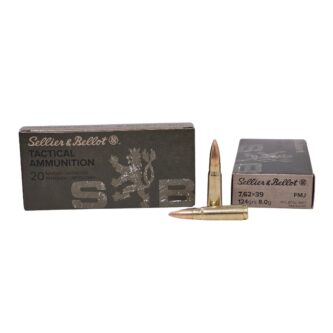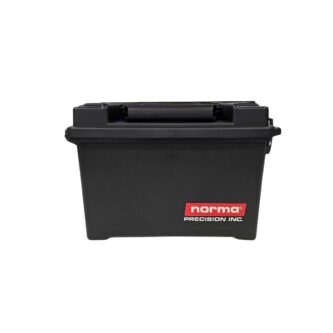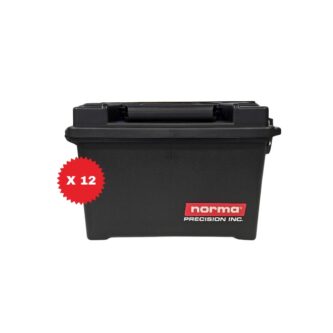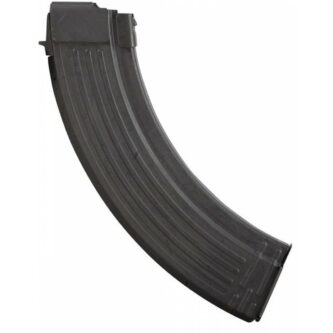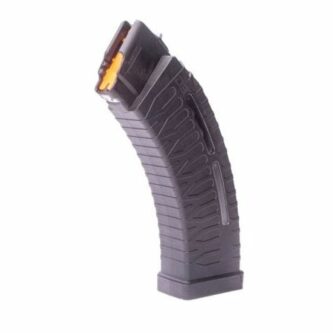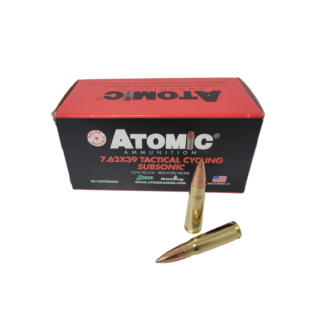Today, we turn our focus to two legendary cartridges that have left indelible marks in both military history and civilian shooting sports: the 7.62x39mm and the 5.45x39mm. Originating from the Soviet era, these rounds have not only shaped modern warfare tactics but also continue to be popular choices among shooting enthusiasts worldwide.
The 7.62x39mm, renowned for its robust performance and association with the iconic AK-47, has been a staple in various combat scenarios and civilian applications. Its larger, heavier bullet has been praised for its stopping power, ability to break through barriers and cover, and reliability in diverse conditions. On the other hand, the 5.45x39mm, which powers the AK-74, emerged as a response to advancements in ammunition technology and battlefield requirements. Known for its higher velocity and flatter trajectory, the 5.45x39mm brought a new dimension to rifle accuracy and effectiveness and earned the nickname “the poison bullet” for it’s uncanny ability to eliminate personnel.
As we set the stage for a detailed comparison of these two Soviet-era juggernauts, we aim to unravel the nuances that define their performance, usage, and legacy. Whether you’re a history buff, a tactical shooter, or a hunting enthusiast, understanding the differences and similarities between the 7.62x39mm and 5.45x39mm cartridges is essential in appreciating their impact and in making informed choices for your shooting needs.
Shop for 5.45x39mm and 7.62x39mm Ammunition
Historical Background and Development
The development of the 7.62x39mm and 5.45x39mm cartridges is steeped in a rich historical context, influenced by military needs and geopolitical shifts. Understanding the genesis and evolution of these rounds provides insight into their enduring significance in the world of firearms.
7.62x39mm: The Birth of a Classic
- World War II Influence: The 7.62x39mm cartridge was developed during World War II, a period marked by rapid advancements in military technology. Its creation was partly influenced by the Soviet Union’s analysis of German Sturmgewehr 44’s intermediate cartridge concept.
- The AK-47 and Beyond: Introduced in 1943 and later adapted for the iconic AK-47 rifle, the 7.62x39mm round quickly became synonymous with reliability and effectiveness in combat. Its design offered a balance between the short-range firepower of submachine guns and the long-range capability of full-sized rifles.
5.45x39mm: Responding to Technological Advancements
- Cold War Developments: The development of the 5.45x39mm cartridge in the early 1970s was a direct response to the Western shift towards smaller, high-velocity rounds, notably the 5.56x45mm NATO used in the M16 rifle.
- The AK-74 and Tactical Shifts: The Soviet military sought a round that would provide better performance in terms of accuracy, range, and wound ballistics. The 5.45x39mm, adopted with the AK-74 rifle, offered these improvements, marking a significant tactical shift in Soviet and subsequently Russian military doctrine.
Geopolitical Factors Influencing Design and Adoption
- Arms Race and Warfare Evolution: The development of both cartridges was significantly influenced by the ongoing arms race and evolving warfare tactics during the Cold War era. Each round represented an adaptation to changing combat environments and enemy capabilities.
- Global Proliferation: The widespread distribution of AK-47 and AK-74 rifles, along with their respective cartridges, was also driven by geopolitical strategies. These rifles and their ammunition became symbols of resistance and revolution in various conflicts around the globe.
The historical development of the 7.62x39mm and 5.45x39mm cartridges is a narrative that intertwines technological innovation with military strategy. Each round was born out of a need to address specific combat challenges, reflecting the ever-changing nature of warfare and the continuous pursuit of tactical superiority. Their legacy, solidified in the annals of military history, continues to influence modern firearm design and usage.
Physical Characteristics and Design Differences
The 7.62x39mm and 5.45x39mm cartridges, while similar in their intermediate rifle cartridge classification, exhibit distinct physical characteristics and design features. These differences significantly influence their performance and suitability for various applications.
7.62x39mm Characteristics:
- Dimensions: The 7.62x39mm round has a wider bullet diameter of 7.62 mm and a case length of 39mm. This results in a larger, heavier cartridge overall.
- Bullet Weight: The typical bullet weight ranges from 120 to 154 grains, with the most common being around 123 grains. This heavier bullet contributes to the round’s significant impact force.
- Design Features: The design is characterized by a moderately tapered case, which aids in reliable feeding and extraction in various firearm actions, particularly in automatic rifles like the AK-47.
5.45x39mm Characteristics:
- Dimensions: The 5.45x39mm has a smaller bullet diameter of 5.45 mm, contributing to its slender profile. The case length is also 39mm, matching that of the 7.62x39mm.
- Bullet Weight: The bullet weight for the 5.45x39mm typically ranges between 52 and 60 grains, with lighter projectiles compared to the 7.62x39mm. This results in higher velocities and a flatter trajectory.
- Design Features: One unique aspect of the 5.45x39mm design is the air pocket located in the bullet’s nose, which shifts the center of gravity rearward. This feature enhances the round’s tumbling effect upon impact, increasing wounding potential and giving the 5.45x39mm “poison bullet” nickname.
Impact on Performance and Use:
- Performance in Range and Trajectory: The 7.62x39mm, with its heavier bullet, delivers more energy on target, making it suitable for medium-range engagements and effective against larger targets. Its trajectory is more arched, requiring compensation at longer distances. The 5.45x39mm, on the other hand, offers a flatter trajectory and higher velocity, lending itself to improved accuracy over longer distances.
- Recoil and Handling: The lighter weight of the 5.45x39mm results in lower recoil, allowing for more rapid follow-up shots and better control, especially in automatic fire. The 7.62x39mm’s heavier recoil is more noticeable but is often considered manageable by experienced shooters.
- Suitability for Various Purposes: The 7.62x39mm is often favored for hunting and close-to-medium range tactical scenarios due to its stopping power. The 5.45x39mm is preferred in situations where accuracy and range are prioritized, such as in military engagements and competitive shooting.
The differences in the physical characteristics and design of the 7.62x39mm and 5.45x39mm rounds contribute to their distinct performance profiles. Each cartridge has its strengths, making them suitable for different shooting needs and scenarios. Understanding these characteristics allows shooters to make informed decisions about ammunition selection based on their specific requirements.
Ballistic Performance and Capability Differences:
The ballistic properties of the 7.62x39mm and 5.45x39mm rounds are integral to their performance and have distinct implications for their use in various scenarios. Analyzing these properties – including velocity, trajectory, and effective range – helps in understanding their impact on accuracy and terminal performance.
7.62x39mm Ballistic Properties:
- Velocity: The 7.62x39mm round typically has a muzzle velocity in the range of 2,300 to 2,400 feet per second (fps). This velocity, combined with the round’s heavier bullet weight, results in significant kinetic energy transfer upon impact.
- Trajectory: Due to its heavier bullet and slightly lower velocity, the 7.62x39mm has a more pronounced trajectory drop at longer ranges. This necessitates elevation adjustments for accuracy at distances beyond 300 meters.
- Effective Range: The effective range of the 7.62x39mm is generally considered to be up to 300 meters, making it highly effective for medium-range engagements.
5.45x39mm Ballistic Properties:
- Velocity: The 5.45x39mm round typically achieves higher velocities than the 7.62x39mm, averaging around 2,900 fps. This higher velocity contributes to a flatter trajectory and longer effective range.
- Trajectory: The lighter bullet and higher velocity result in a flatter trajectory for the 5.45x39mm. This characteristic enhances the round’s accuracy at longer distances, reducing the need for significant aiming adjustments.
- Effective Range: The effective range of the 5.45x39mm extends to about 500 meters, making it well-suited for engagements that require long-range precision.
Impact on Accuracy and Terminal Performance:
- Accuracy Considerations: The 5.45x39mm’s flatter trajectory and higher velocity lend themselves to greater accuracy, particularly at longer ranges. The 7.62x39mm, while less accurate at longer distances, is highly effective at medium ranges due to its larger bullet mass and energy.
- Terminal Performance: The 7.62x39mm is known for its robust terminal performance, delivering substantial impact and energy transfer, making it suitable for larger targets. The 5.45x39mm, with its tumbling effect upon impact, creates significant wound channels, compensating for its smaller size with enhanced wounding potential.
The ballistic performance of the 7.62x39mm and 5.45x39mm rounds offers a study in contrasts. The 7.62x39mm excels in delivering powerful, medium-range performance, while the 5.45x39mm stands out in long-range precision and accuracy. Each round has distinct advantages in specific scenarios, influenced by their ballistic properties and the strategic considerations these properties entail.
Rifle Compatibility and Availability
Understanding the types of rifles commonly chambered for the 7.62x39mm and 5.45x39mm cartridges is essential for shooters, as it directly affects the availability and practical use of these firearms and their ammunition in today’s market.
Rifles Chambered for 7.62x39mm:
- Iconic AK-47 and Variants: The most famous rifle chambered for the 7.62x39mm cartridge is undoubtedly the AK-47 and its various derivatives. This rifle has seen widespread use globally, renowned for its durability and reliability.
- Modern Sporting Rifles: In addition to traditional AK-style rifles, the 7.62x39mm cartridge is also used in a range of modern sporting rifles, including those based on the AR platform. Manufacturers have adapted the AR platform to accommodate the 7.62x39mm, appealing to a wide range of shooters.
- Bolt-Action and Hunting Rifles: There are also bolt-action rifles chambered in 7.62x39mm, catering to hunters and shooters looking for a more traditional shooting experience with this cartridge.
Rifles Chambered for 5.45x39mm:
- AK-74 and Its Variants: The primary rifle for the 5.45x39mm cartridge is the AK-74, the successor to the AK-47. The AK-74 and its variants are less common than the AK-47 but are praised for their improved accuracy and lower recoil.
- Limited Availability in Western Markets: Compared to the 7.62x39mm, rifles chambered in 5.45x39mm are less commonly available in Western markets. However, there is a niche market for these rifles among enthusiasts and collectors.
Availability in Today’s Market:
- 7.62x39mm Rifles and Ammo: Due to the widespread proliferation and enduring popularity of the AK-47 and its variants, both the rifles and 7.62x39mm ammunition are widely available in today’s market. This availability is further bolstered by the cartridge’s adoption in modern sporting rifles.
- 5.45x39mm Rifles and Ammo: While there is growing interest in the 5.45x39mm, the availability of both firearms and ammunition in this caliber is more limited compared to the 7.62x39mm, especially in Western countries. However, for enthusiasts and aficionados of Eastern Bloc military hardware, the 5.45x39mm offers a unique shooting experience.
The rifle compatibility and market availability for the 7.62x39mm and 5.45x39mm cartridges vary significantly. The 7.62x39mm remains a highly accessible and versatile choice due to the wide range of rifles available and the global proliferation of its ammunition. On the other hand, the 5.45x39mm, while more niche, holds a special place among certain shooting circles, offering unique advantages in terms of performance and historical significance.
Benefits and Drawbacks of Each Cartridge
When comparing the 7.62x39mm and 5.45x39mm cartridges, it’s important to consider their respective benefits and drawbacks. These factors can significantly influence a shooter’s choice based on their specific needs, preferences, and shooting contexts.
Benefits of the 7.62x39mm Cartridge:
- High Impact Power: The 7.62x39mm is known for its significant stopping power, making it effective for hunting and tactical scenarios where this is a priority.
- Wide Availability: Given its global proliferation, both the ammunition and rifles chambered in 7.62x39mm are easily accessible and often more affordable.
- Versatility: This cartridge is used in a variety of rifle platforms, from the classic AK-47 to modern sporting rifles, offering flexibility for different shooting styles.
- Effective at Medium Ranges: Its performance at medium ranges is highly reliable, suitable for most hunting and combat situations.
Drawbacks of the 7.62x39mm Cartridge:
- Heavier Recoil: Compared to the 5.45x39mm, the 7.62x39mm typically has a more noticeable recoil, which might affect rapid follow-up shots or shooter comfort.
- Trajectory Drop at Longer Distances: The bullet experiences more pronounced drop at longer ranges, requiring more skill for accurate long-distance shooting.
Benefits of the 5.45x39mm Cartridge:
- Flat Trajectory and High Accuracy: The cartridge’s higher velocity and flat trajectory enhance long-range accuracy, making it suitable for precise shooting.
- Reduced Recoil: The lower recoil improves shooter control, particularly in rapid fire or continuous shooting scenarios.
- Enhanced Wounding Capability: The unique design of the bullet, with its tendency to tumble upon impact, results in increased wounding potential.
- Ammunition is typically less expensive: Though sometimes more difficult to find, the ammunition is less expensive that the 7.62 counterpart.
Drawbacks of the 5.45x39mm Cartridge:
-
- Limited Rifle and Ammo Availability: In Western markets, finding rifles and ammunition for the 5.45x39mm can be more challenging compared to the 7.62x39mm.
- Less Stopping Power: While effective for wounding, the 5.45x39mm generally has less stopping power than the larger 7.62x39mm, which can be a consideration in hunting or tactical applications.
- Corrosive Ammo: Much of the ammunition in the 5.45x39mm line are considered corrosive and you will need to clean your gun after shooting.
Both cartridges offer unique advantages and have certain limitations. The choice between the 7.62x39mm and 5.45x39mm cartridges will largely depend on the shooter’s requirements for power, range, recoil, and availability. Understanding these benefits and drawbacks allows shooters to make a more informed decision aligned with their specific shooting needs and preferences.
Safety Concerns:
Be VERY CAREFUL not to mistakenly load a 7.62 mag with 5.45 or vice versa. The cartridges will fit in either mag and would be a costly and potentially harmful mistake if fired!
Shop for AK-47 and AK-74 Ammo
The debate between the 7.62x39mm and 5.45x39mm rounds encompasses much more than mere preference—it’s about understanding the unique characteristics that define each cartridge’s suitability for different needs. Our comparison has highlighted several key points that set these two rounds apart.
Key Points of Comparison:
- 7.62x39mm: Known for its robust stopping power and reliability, the 7.62x39mm shines in medium-range engagements and is favored for its performance in hunting and tactical applications. Its widespread availability and the sheer variety of platforms that chamber it make this cartridge a versatile and accessible option for shooters around the globe.
- 5.45x39mm: With its flatter trajectory and reduced recoil, the 5.45x39mm excels in accuracy and control, making it ideal for shooters who prioritize precision, especially at longer ranges. The tumbling action upon impact creates significant wounding potential, despite the round’s smaller size.
Unique Advantages for Informed Decision Making:
- 7.62x39mm Advantages: This cartridge is an excellent all-rounder, balancing power, and accessibility. It’s particularly advantageous for those who require a heavy-hitting round for either close-quarters defense or medium-range hunting scenarios.
- 5.45x39mm Advantages: Shooters looking for a cartridge with high accuracy and low recoil for competitive shooting or extended range engagements will find the 5.45x39mm to be a superior choice.
When making a decision between these two storied cartridges, consider your intended use—whether for sport, defense, or competition—as well as your preferences in handling and performance. Both rounds have proven their merit through decades of rigorous use and continue to be respected members of the ammunition community. By weighing their differences and strengths, you can choose the cartridge that aligns best with your shooting requirements and ensures a satisfying and successful experience.
At KIR Ammo, we pride ourselves on offering great prices on ammo every day, ensuring that your exploration of these cartridges is not only informed but also cost-effective. Take advantage of our extensive selection to find the perfect match for your firearm and shooting needs. Browse our massive inventory of ammo, and don’t hesitate to reach out with questions or for recommendations. Whether you’re a seasoned shooter or new to the game, KIR Ammo has discounts on the ammunition you’re looking for every day!
5.45x39mm vs. 7.62x39mm FAQ:
- Is 7N6 ammo banned? In 2014, the United States banned the importation of 7N6 5.45x39mm ammunition, classifying it as “armor-piercing” under federal law. This ban only affects the importation of this specific type of ammunition and does not apply to 5.45x39mm ammo in general.
- Why is 7N6 called the poison bullet? The 7N6 is sometimes referred to as the “poison bullet” due to its terminal ballistics. The bullet has a hollow space at the front and a steel core, which causes it to tumble upon impact, creating more significant tissue damage than a standard full metal jacket (FMJ) round. This tumbling effect is responsible for the nickname.
- Can I shoot 5.45 in a 7.62 Magazine? While 5.45x39mm cartridges might physically fit into a 7.62x39mm magazine, it is not recommended to use them interchangeably. The dimensions and cartridge specifications are different, which can lead to feeding issues, reduced accuracy, and potential damage to the firearm.
- Is 7N6 armor piercing? The 7N6 was classified as armor-piercing by the U.S. Bureau of Alcohol, Tobacco, Firearms and Explosives (ATF) due to its steel core. However, its primary design was not for armor penetration but for improved ballistics and terminal performance.
- Which is better, 5.45 or 7.62×39? “Better” depends on the intended use. The 5.45x39mm offers less recoil, a flatter trajectory, and increased accuracy at longer ranges. In contrast, the 7.62x39mm provides more stopping power and better performance through barriers. Each has its advantages depending on the shooting context.
- Are 5.45 and 7.62 interchangeable? No, they are not interchangeable. These cartridges have different dimensions and ballistic properties. Using one in a firearm chambered for the other can be dangerous and is strongly advised against.
- What is 5.45x39mm equivalent to? There’s no direct Western equivalent to the 5.45x39mm. It’s often compared to the 5.56x45mm NATO due to similar ballistic properties like flat trajectory and high velocity. However, the two are not interchangeable, and each has distinct characteristics.
